Iran 2007
The Story of Iran - October 2007
The first problem was obtaining a visa. We planned this business trip with a participation of three various nationalities, Indian, German and Czech. The aim of the journey was taking part in an exhibition/conference and promoting our product, a partial cement replacement in concrete Pozzocrete. Therefore we applied for a business visa. First of all we had to provide various kinds of non standard paperwork: a company bank statement, a certificate by Indian Chamber of Commerce confirming our existence, medical certificate confirming that we do not have HIV, tuberculosis and hepatitis (all these diseases are apparently mostly spread in the Western civilization therefore only healthy Westerners are admitted), invitation by our Iranian distributor and some others.
After having obtained all this, we were informed that the Czechs and Germans cannot get a business visa at all, only on the direct instruction of the Ministry of Foreign Affairs in Tehran, which would have to be provided by our distributor in Iran. The Indian citizens could get the business visa directly in Mumbai. But there was another paper missing which was not mentioned earlier, an official request for visa by company Dirk. Our employee in Mumbai briskly walked into an internet cafe situated around the corner from the Iranian Embassy, we sent him the scanned letter on Dirk letterhead, he had it printed and it seemed that the first round of fight with the bureaucracy had been won. But it was not. As per the rules it was not possible to pay for the visa on spot in cash, the only way was to deposit the amount in rupees at their account in the nominated bank. When our employee Harish reached the bank, the employee congratulated him because for quite some time he had not seen anybody who would manage to get so far in his request for business visa.
This meant that the visa for Indian national was sorted. But what to do with the visa for Czech and German citizen? In the end it turned out that the only solution would be a tourist visa, but again the status of both nationalities was different. The Germans could get a seven-day tourist visa on arrival at the airport in Tehran, but the Czechs would get only a three-day transit visa at the airport without any possibility to extend (three days were not enough for our stay).
This reminded me the situation nearly 40 years ago when we planned our Indian expedition from West Berlin: we obtained double transit visa (for going through the countries and return trip) from all the countries, including Pakistan and Afghanistan, but the Iranians claimed that the double transit visa did not exist in their system. This was also the reason why we could not return to Europe via Iran (my passport was already full of visas and stamps and nothing else fitted there), but we had to look for a vessel that would take us from the Indian port of Mumbai to Basra in Iraq (ten days at sea). Even at that time Iran was the most complicated of all although it was still in the time of rule of Shah.
Back to the present: the only way to get a visa for me was that our distributor Amir would go to the Ministry of Foreign Affairs in Tehran, overtake full guarantee for me, and apply for the visa there. Finally he wrote that he had pleasure to let me know that the Minister of foreign affairs of Iran gave permission for granting my tourist visa. We received a number which should be presented by our employee at the Iranian consulate in Mumbai and on this basis my visa should be affixed into the passport.
But time was getting tight. It was Wednesday, we had to fly on Friday, we booked the hotel and flights but it was still not one hundred per cent sure what will be the outcome with my visa. On Wednesday at 12.00 o´clock the consulate in Mumbai opened and poor Harish was already waiting there (it was already for the 6th time and some Iranian clerk shouted at him why did he keep coming that he would not get the visa anyway). When it was his turn to see the consul he showed him my passport and the relevant number from Ministry of Foreign Affairs in Tehran. He was told that this time everything was fine, except that the time for issuing the visa is 24 hours. It was Wednesday, they had a public holiday on Thursday and on Friday they were closed anyway. I do not know what Harish did, if he started to cry, but eventually he was told to come on the same Wednesday at 4 pm and they would see what they could do. So he obtained the visa at 15.45 (the consulate closed at 16.15 for two days) and I could travel.
Booked tickets were purchased last minute without any problems (probably not so many passengers fly to Iran). In the end even the hotel accommodation had to be booked by our distributor, because no hotel accepted either credit cards or debit cards.
In preparation for the trip I also had to purchase abaya (or abayah), a long black cloak with a black scarf. In some countries like Saudi Arabia women have to wear so called burqa which includes voluminous cloak, scarf covering the hair and full face veil with only slits for the eyes. Fortunately this type of dress is not required by law in Iran.
Initially I was told by Amir that a scarf or shawl covering hair would do for me as a foreigner, but then he got scared what the reaction might be in the state conservative institutions where we also planned some meetings.
So the black abaya had to be provided and my colleagues in Nashik started to look for it. As they are not Muslims, and Muslims are not prevailing in Nashik population, they had to phone around only to find out that traditional Muslim women in Nashik let their abayas and burqas to be made and embroidered. They managed to receive the address of only one store in Nashik which sold ready-made abayas - the quoted price was from 500 to 700 rupees, which is 250 to 350 Czech Crowns or 10 Euros.
My driver took me to a Muslim neighborhood, where I had never been before. The increased poverty in comparison with other parts of Nashik was obvious. The so-called store was a stand with twelve years old boy hanging around presenting not more than ten pieces of abayas/burqas for sale. I tried one of them – but there was nothing much to be tried, they were all of the same size. When I offered him the price, which abaya was supposed to cost the boy said that he could not sell anything, because he did not know the prices, we had to wait for his daddy, daddy would be coming in an hour. Our conversation was very limited as the English knowledge of the driver was also very limited and the boy obviously did not speak any English at all. So when I asked where the father was, I was told that "the father was watching dead body." By that I understood that he probably attended a funeral, which then meant that he could come back any time between one to five hours.
There was no joy for me in this. So we went back to the office, mobilized our team in Mumbai and they provided an abaya without testing. But everything turned out fine, see the picture.
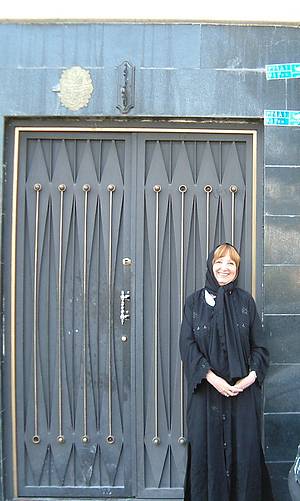
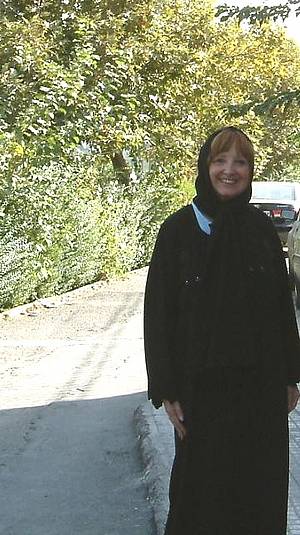
In Abaya - before official meetings
Departure and first impressions
The moment of departure came. Upon entering the aircraft of Iran Air all the women had already scarves prepared around their neck, some of them put them on already on the plane (probably Iranians), others, like me, only on the exit from the aircraft.
I was in Tehran in 1970 during the hitchhike expedition to India and I remembered the city as surrounded by mighty mountains. At that time, under the Shah, there were no mandatory headscarves or abayas. The mountains did not let me down, they were still exactly as impressive as before, and as a matter of fact I was not disappointed by the city either. Tehran has a population of 15,000,000 (similar to the official number of population in Mumbai, the whole country has 67 million), but there are no slums, dirt or mess to be seen – neither the visible contrast of enormous wealth and depressive poverty, a feature so typical for Mumbai and other Indian cities, could be observed in the streets of Tehran.
The city looked slightly weathered, but lively construction activities were going on in many places. However, it is all possible because Iran has big oil reserves. In stores and shopping malls everything is available. The streets are long, straight, well-maintained, with trees, mostly with very attractive old maples, planted on both sides, the city is very much green.
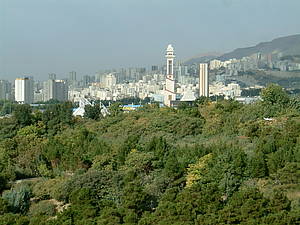
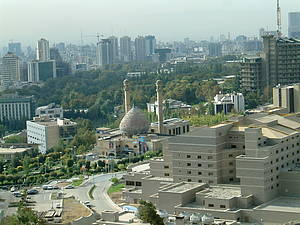
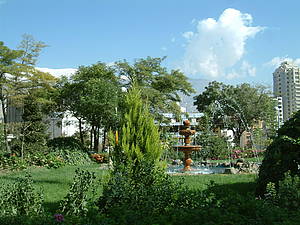
Tehran in Green
There is a large selection of restaurants with good food, especially barbecue and steaks (Iranians are not vegetarians, there is only one vegetarian restaurant in Tehran). At night the city is beautifully lit. There are some major museums there, mostly in the former residences of the Shah, but when we had a chance to visit, it turned out that they had the same custom of museums being closed on Monday as in Europe. Otherwise, the most interesting thing in the city is how it is situated – when we woke up one morning, the tops of the mountains were already white after last night's snow storm.
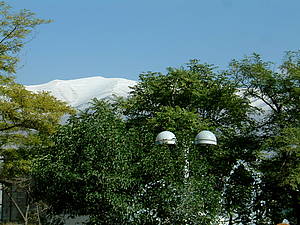
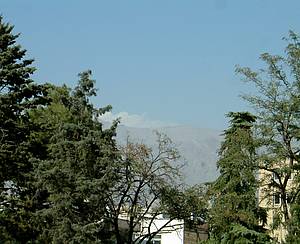
Tehran mountains with snow top
Ancient history and religion.
To understand the presence, it is always necessary to understand the history. Iran used to be Persia and Persians are not Arabs. Persian Empire was flourishing in the 1st millennium BC, when it was conquered (330 BC) by Alexander the Great. Arab conquerors seized the land only in 7th century AD, when Iran became a part of Abbasid Caliphate. Since then, the influence of Islam in the country was strong and today the whole country belongs to the Shia branch of Islam. From the original religion of Zoroastrianism (the prophet Zarathustra comes from Iran), only a small minority is left, even though it is considered the oldest monotheistic religion in the world, with a strong emphasis on the struggle between good and evil, which was taken over by most other monotheistic religions. The symbol of one god in this religion is fire and this symbol was subsequently overtaken by the Parsees in India. Otherwise, there is a small minority of Armenians, Chaldean and Syrian Catholics (we saw a church) and a few Jews in Iran.
Modern history
Since the beginning of the 20th century, because of the oil discovery, Great Britain and Russia were fighting for the influence over Iran. Iran remained neutral in the First World War, but there were still several battles led between the Russians and the British for dominance over the Iranian oil fields. The British presence was discontinued in 1923, when Reza Khan seized the power and was elected Shah. He began an extensive program of westernization and infrastructure improvements. Sunni Muslims were forced to wear western hats instead of the traditional fez hats, which caused a violent rebellion among the clergy. Reza´s wife and daughters discarded the veil and the majority of Iranian women followed (probably happily).
Iran remained officially neutral also during World War II, but in reality it supported Germany by refusal of passage to Russian and British Armies. Both countries occupied Iran soon after that, Russia in the north and Britain in the south - the Shah abdicated. His son and successor Mohammed Reza Shah Pahlavi promoted friendly politics towards Alliance and was rewarded by Anglo-Russian economic and military aid and by removal of foreign troops in 1942. Roosevelt, Churchill and Stalin signed so called Declaration on Iran in 1943 which guaranteed the country's sovereignty and territorial integrity.
In the middle of the post-war turmoil a dictator Mohammad Mossadegh came to power and nationalized the oil industry. The dictator was removed in 1958 and U.S. oil companies received an absolutely non-precedential 75 percent share in the profits of Iran. The reestablished Shah Reza Pahlavi carried out so called White Revolution, during which he transferred two million hectares of land owned by landlords to small farmers. In the sixties and seventies (that was the time I was there) Iran flourished, but then foreign investment began to fade.
Mohammad Reza Pahlavi created a one-party rule, built a strong secret police called Savak and always brutally intervened against any opposition. These dictatorial manners aroused opposition among Shia clerics led by Aytollah Khomeini who returned after 16 years of exile in Paris and declared the Islamic Republic. Reza Shah fled after 37 years of governing and was accepted in the United States, which caused an attack of militant forces at the U.S. Embassy in Tehran with sixty six captured American hostages. They were released on the basis of Algiers Accords in 1981 (only after 444 days and after failed American rescue operation which cost 8 lives).
Everyday life in Iran
Meanwhile, the government was taken over by Shia clerics who rule Iran until today.
The first issued law ordered to women to return to the traditional clothes and segregated men and women in all spheres of life (for example, there are beautiful beaches on the Kish Island where women can bathe, but only in separate places surrounded by a fence – they can apparently even wear bikini there).
All cinemas were closed (meanwhile they reopened, but Western movies are censored, especially when it comes to sex and violence), all pop music of western type forbidden (that continues till today, but only in the public, at home, the youth plays what they want). The only valued culture is the traditional one, i.e. no modern art (only classical paintings in the galleries, nothing in mosques, of course), no modern literature, no modern music (only classical music concerts). Also satellites are strictly prohibited.
But as I was informed there is an absolute contradiction, type of schizophrenia, between the public and private lives of Iranians. At home they are hosting parties, drinking alcohol, which is available at the black market, dancing, seeing video films which had been the latest blockbusters in Europe. They love to eat well and plentifully. Amir explained that his parents' generation knew all these freedoms in their young days, and so most middle class parents try to raise their children accordingly and enable them similar freedom which they could enjoy at least within the privacy of their homes and families.
However, in the public, a strict control is actually implemented. Girls in Tehran are very attractive – as they are not forced to wear burqa, we could see their beautiful faces. The dressing code says that females have to wear trousers and black or gray cloak long at least below the knees and a shawl. The inventive women wear jeans, sort of long black blouse covering also knees but nicely tight, and they cover their hair by an elegant scarf in various colors.
Black color is very much preferred in Iran, so when I planned to put on my black business suit with blue blouse for the next day meeting, Amir advised that I should rather not have any other color but black and I had to purchase a black blouse on spot. I like black but not completely black and I looked like a crow, but some of the young generation in Europe (including my daughter) would have nothing against this black fashion, I am sure.
The Iranian women have not much choice for variety of their clothes so they revel in a very expressive make-up which is quickly removed from the face when the news spreads about turn of green morality police in the streets (this information is handed over by mobile phones from friend to friend). It is hard to believe, but Tehran actually has both blue traffic police, and green morality police. The green police stops on the streets inappropriately dressed or made up women, who are being reprimanded for not sticking to the law, sometimes taken to the police station where they have to listen about their crimes. Usually they are then set free, but if it would be a repeated serious ofence against the dress code, they might finish in prison.
It is said that foreigners are not the real target, but I would rather not risk it. This police checks also other things. For example, we were in Iran during Ramadan. No one is allowed to eat or drink it the public, it also applies to foreigners. Fortunately, when it comes to the foreigners, restaurants of large hotels are not considered "public", so visitors can get at least something.
But when we spent all day in Tehran going from one meeting to another, most business partners apologized that they could not offer us anything, even not a glass of water because of Ramadan. In some private companies they took a chance and brought us cup of hot water with a box of nescafé and milk powder so that we could make ourselves a cup of coffee. Eating is allowed only after sunset. To be fair, they do make some exception when taking meals is permitted, for example, in the case of sick people, pregnant women, very small children and, strangely enough, also for the Iranians who are traveling.
Another custom: traditional Iranian men do not shake hands with women when introduced or greeted, but in the business meetings in private companies this rule is not being kept. It is similar as in most Persian Gulf countries like Emirates, Qatar, Oman so I was used to it. Women in Iran are allowed to drive, in difference to Saudi Arabia.
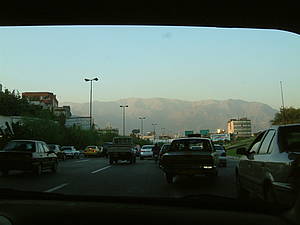
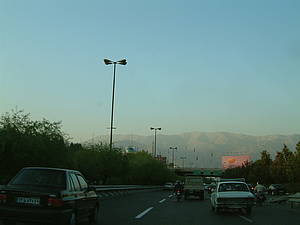
Traffic in Tehran - mountains in the background
Development since eighties until today
To understand better further development in Iran, it is necessary to mention the devastating war which country led with Iraq in the years 1980 to 1988. Iraq with Sadam Hussein as president was the one who attacked because he wanted to usurp part of Iran´s territory. The Shia clerics who ruled Iran at that time had strongly negative attitude against the West and therefore the West, mostly Americans, decided to support with full force the "secular" Saddam regime. From this period we could see the photos of U.S. Secretary for Defense embracing friendly the Iraqi dictator (from today's perspective photos of Judas). The Americans supplied to Iraq all, including chemical weapons, which Sadam ruthlessly tested decimating Iranian as well as his own civil population. The war ended in a draw, there were no winners, only losers.
After the death of Khomeini in 1990, Iran reestablished formal relations with Iraq, but in the Gulf War, when Saddam invaded Kuwait (Americans managed to get him out very quickly), Iran remained neutral. President Rafsanjani repeatedly won the election in 1992, but he failed to lead the country out of the economic crisis. He remains a contradictory figure in Iranian history, because although he was considered more liberal than his predecessor, he restored the death sentence fatwa against the native Indian writer Salman Rushdie (for his novel The Satanic Verses) and also faced suspicion that he supported terrorist fundamentalists in Egypt and Algeria.
Problem with the bomb
In 1995 the United States accused Iran of attempt to develop production of weapons of mass destruction and initiated embargo against Iran. Europe and the Japanese did not follow. In 1997 a moderate cleric Muhammad Khatami won the election and he tried to smooth the relations with the West.
The problem with nuclear energy is not simple. Iran is together with other 120 countries a signatory to international Agreement on non-proliferation of nuclear weapons, thereby allowing the international community to control its nuclear reactors, which Iran claims are meant only for peaceful purposes, i.e. for the production of electricity.
Few people know that India, Pakistan and Israel, although they already have the nuclear bomb, never signed this Agreement. It is of course absolutely unfair (even if we do not consider the fact that Britain, France and USA have nuclear weapons themselves) that for such a country as Pakistan, the right to have a nuclear bomb is not being questioned only because their president cringes to the U.S.. However, this is what Pakistan government is doing at the moment, but no one knows when they might change alliances (see Sadam Hussain in Iraq).
On the other hand, it is not clear whether the international community should believe that the Iranian government really develops the nuclear technology only for peaceful purposes. In their situation, when they look across the border into Iraq, it would be only logical if they wanted to have the bomb at least as a deterrent for their defense (hopefully not for anything else). Because those who own a nuclear weapon do not need to be afraid that someone will just bomb them – typical example North Korea. Iraq had no weapons of mass destruction (and the Americans knew it), and that became fatal for Saddam, when he became uncomfortable (though previously he exchanged kisses with the U.S. politicians).
However we might take it, it is of course advisable that nuclear weapons should not be further spread to more countries, it is complicated enough with those who already have them, and from this point of view it would make sense to prevent the Iranians from having such a dangerous weapon in their hands (but not by throwing bombs on their towns).
The moderate Mohammed Khatami was president till 2005 and he helped to mitigate some excesses of religious fanatics. However, the president of Iran is only in the second place of hierarchy after the religious leader, who is called the Supreme Leader, and the Parliament called Majles has no jurisdiction to enforce the laws which are vetoed by the religious council. Supreme Leader of Iran is presently Ali Khamenei. At the time of our stay Mahmoud Ahmadinejad was the elected President.
When I asked what are the procedures during elections, and why the population would not select somebody who was against religious despotism (we did not meet anybody in Iran who would be happy with the present situation, although we obviously moved in a narrow circle of people, and only in Tehran), the answer was that there is no real choice of candidates, all candidates are more or less connected with clerics, only one party is considered moderate, and that is the one whom the intellectuals give their votes.
Unfortunately President Ahmadinejad decided that he would have a go at the U.S. again, but Iranians are not thankful for this controversial course. During one night in Tehran, I had a dream and told it to Amir. I dreamt that seven million women of Tehran took to the streets and all at the same moment took off their scarves (I know that it was just a dream, impossible to organize in reality). But I asked Amir what would happen if women would really do it. Amir said that in the case of street demonstrations the government would not hesitate to shoot because there is a declared emergency state in Iran (that´s how they feel due to constant verbal attacks and threats of the U.S.A.). But Tehran's seven million women could not be shot by government whatever they would do, so maybe it happens one day.
Ladies, let me tell you that wearing the headscarf all day especially in the room is a headache. My head was sweating and hair style made in India disintegrated in two hours. But the coiffure must be irrelevant because an Iranian woman does not show her hair style in the public anyway and when she takes the scarf off at home, it probably does not matter if her hair looks horrible (it is “just” the husband who can see it).
One more curiosity: women are always wearing a burqa or headscarf in Iranian films, even at home or in bed (meaning when they are shown sleeping, nothing else is shown, of course). When you think about it, it is a paradox, because in the real life it does not look like that, of course a woman is allowed to take the scarf off at home in the family circle. But women in the movies on the screen show themselves to foreign men (everybody is watching), so the actresses are not allowed to take the scarf off. Normal Iranian men find it stupid and I have to say that they were not afraid of giving their opinion on the issue of scarves, clothes but also on other matters. For example, we used during the business trip various taxis, and our friends discussed between themselves and with us completely uninhibited. Most of taxi drivers did not speak English but some of them did and our hosts could not know how far they could understand whatever had been said – yet they were not afraid.
Exhibition
However, we experienced a nice example of complicated life in Iran in the context of our announced participation in exhibition on concrete production.
This exhibition was also the reason why it was so important to fly exactly in this time and why we had to suffer the nerve breaking exercise with the visa – we could not postpone the departure. Just imagine two big black barrels, in which we had folded our stand, newly made bill-boards, magnetic mounts, aluminum rails, everything perfectly prepared, top notch. It weighed all together around 70 kg. We trudged the barrels through the customs in Mumbai and Tehran, dealt with customs formalities so that we could bring the stand back duty-free, paid for excess baggage.
On the eve of the exhibition we wanted to erect the stand, but only one barrel fitted into Amir's car. Therefore Amir and our colleague Mukund were sent as the vanguard and they should have come back to collect the second barrel and remaining crew. The exhibition was held at the Tehran University. Both of them had gone, and were not coming back for a long time. When they appeared, they were in a state of a total shock.
Suddenly, exactly on the day of the exhibition, President Ahmadinejad decided to visit the University (for other purpose, not to see the exhibition). This decision increased the security precautions of the University to maximum. On the next day the Iranians would be admitted to the University premises only on the basis of identity card and fingerprints, foreigners would not be admitted at all. No exception permitted. That meant the end of our participation in the exhibition.
Amir would not be able to erect the stand without our help (it needed two persons anyway but he had never built it before). It was decided that he would go there on his own without stand, talk with the exhibitors and distribute brochures, and return after noon. This gave me a theoretic opportunity to do some sightseeing in the town, but unfortunately museums were closed on Monday. So the only thing that was open was the local bazaar, which also belongs to main tourist attractions. We bought a small Persian rug for our bedroom after a long haggling in which George is a champion.
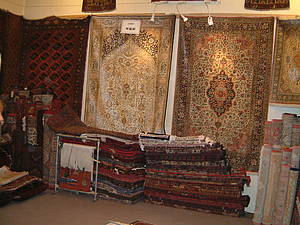
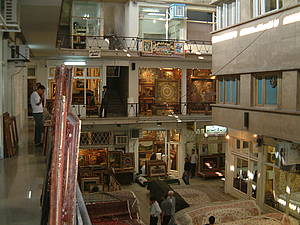
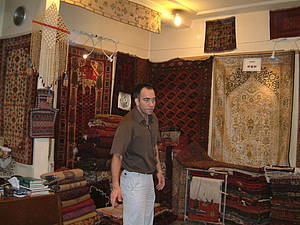
Carpet Bazaar
At noon we called Amir, but he was still standing in front of the gates of the University. The security people seemed to discharge people one by one. The reason for even more obstacles than expected was the student demonstration outside the University which was later reported about by CNN in the evening news. They reported that one part of students chanted "Death to the dictator", and the other part chanted "Thank you, Mr. President." This shows that not only society, but even student community (normally the most revolutionary section of society) is split into two irreconcilable camps. Fortunately, no major violence took place (I think that the protest was numerically limited, and the students eventually broke up or were dispersed by the police), no shooting, which Amir had feared. The Iranian press reported about the visit of the President at the University, but they tactfully did not elaborate on the circumstances. Amir got inside the building in the end, handed out the brochures, but the main promotional effect of our perfect stand was lost. Strange, wherever we appear, there is an earthquake, flood or "riots", fortunately no revolution.
Conclusion
There are many well-educated, friendly people living in Iran. Everyone we spoke to desired a reconciliation with the West and a normal life (not really surprising, is it?). To develop or not to develop the nuclear program is for Iranian middle class an uninteresting topic, certainly not a matter of national honor as it is sometimes presented by their government. As far as our trade with Iran, we received orders from two major companies, but to do business with Iran is difficult as even opening of a Letter of Credit is a major administrative operation for them.
The last evening, we went to the mountain at the outskirts, called Rock of Darakeh. There is a huge complex of restaurants in the great palace built on one of the hills. The complex has about 8 open terraces, guests are climbing up the stairs, stopping when they do not want to go up anymore and entering one of the restaurants that serves delicious dinner. Below the mountain there is a colorful bazaar. It was one of the nicest evenings we spent in Tehran. Our distributor is an example of modern Iranian who had to adjust to the situation on the outside, but otherwise he lives his private life as best as he can. As always, when you get acquainted with people, you can only wish them all the best, peace, tranquility and better rulers.
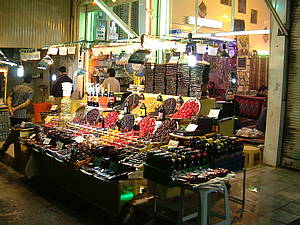
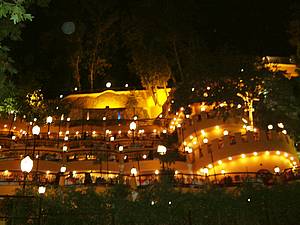
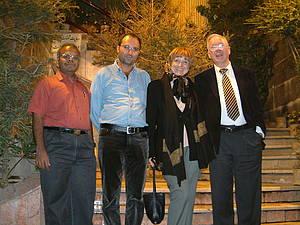
Darakeh
Note as per 2012. The report above was written 2007. The situation in Iran escalated later on, the embargo toughened, the Iranian accounts abroad had been frozen, it was difficult for companies to transfer the money even if they had it because transferred money was confiscated in the United States. Some of our customers still found the ways how to continue the business but it became more and more risky and finally we stopped exporting to Iran. In the end our distributor and his wife could not stand the pressure any more and emigrated to Australia.
Note as per 2013. With the election of the new Iranian president, moderate Hasan Rouhani, there seems to be a thaw in the relations between Iran and U.S.A.. Negotiations of the Group 6 restarted in Geneva resulting in a partial removal of economic sanctions against Iran´s promise to have their nuclear material under strict control. The upcoming year could be more positive for the country which is suffering since years under international isolation.


